In the ongoing somewhat surreal operation against piracy off Somalia, the HDMS Absalon, a Danish destroyer, sank a pirate “mother ship” but allowed the pirates to return to shore. The official goal appears to be to “disrupt” rather than stop pirate activities. Thus far the naval flotilla has proven itself a significant inconvenience to the Somali pirates but little more. It appears that the nation states involved continue to lack the will to arrest and charge the pirates under international law. A policy of ”catch and release” works well for stocking trout streams but does little in stopping piracy in one of the most important shipping lanes in the world.
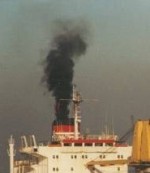 Is a ship the “greenest”, most efficient means of transportation or is the dirtiest? It is easy to be confused about hoe clean or dirty ocean transportation may be from reading the newspapers.
Is a ship the “greenest”, most efficient means of transportation or is the dirtiest? It is easy to be confused about hoe clean or dirty ocean transportation may be from reading the newspapers.
Transportation by water has always been the most efficient means of moving goods over distance. At the turn of the 19th century the cost of transporting an item across the Atlantic by ship was roughly the same cost as moving it 30 miles inland. With canals, railroads and highways, overland efficiency has improved, but, nevertheless, things haven’t changed so much.
A study by National Geographic on the transport of wines reflects this, as expressed by the carbon footprint of the shipment. If you live in New York, a French wine, transported by ship, can have a carbon footprint of only an equivalent to only 0.3 pounds of CO2, whereas a California wine, transported overland by truck, has a carbon footprint of 4.4 pounds.
Ship or Truck Transport Makes All the Difference in Wine’s Carbon Footprint
Continue reading
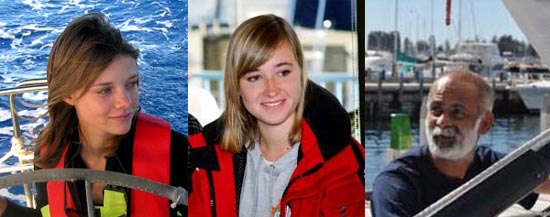
Jessica, Abby, & Dilip
Here is an update on the circumnavigation attempts under way by Jessica Watson, Abby Sunderland and Commander Dilip Donde. The last name may not be as familiar as those of the blonde teenagers. The 42 year old Indian Navy Commander is on the last leg of his quest to be the first Indian to circumnavigate the globe singlehanded. He recently stopped at Cape Town on his way to Mumbai, literally one ocean away from his destination.
Continue reading
 The Port Norris Rotary presents the 13th annual “Run for the Schooner” a 5K run, walkathon & 1 mile fun run/walk on Saturday, April 10, 2010, to benefit the A.J. Meerwald, the official Tall Ship of the State of New Jersey.
The Port Norris Rotary presents the 13th annual “Run for the Schooner” a 5K run, walkathon & 1 mile fun run/walk on Saturday, April 10, 2010, to benefit the A.J. Meerwald, the official Tall Ship of the State of New Jersey.
To learn more call 856-785-2060, or visit the Bayshore Discovery Project .
The A.J. Meerwald is an authentically restored 1928 oyster schooner operated as a hands-on sailing classroom throughout the region as well as offering shore-based programs and events in her home port of Bivalve on the scenic Maurice River in Cumberland County.
Continue reading
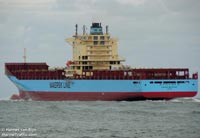
MAERSK BEAUMONT Photo: Hannes van Rijn http://www.marinetraffic.com
We have recently posted about the roller coaster ride that has been container ship design over the last few decades. See Containerships – from Slow to Fast to Slow to Fast to Slow Again. The smartest minds in the shipping industry have not been able to predict what the right speed for the box boats will be. One example of this are the seven virtually new 4,000 TEU Maersk B Class ships designed to operate at 30 knots, all of which went almost directly into layup. What a difference a couple of years makes – Maersk, which spent an estimated $350 million dollars to build these 30 knot ships, is now “slow steaming” much of its fleet at 12 to 14 knots. Financial Times had a recent article about the plight of the Maersk B Class Ships.
World’s fastest container ships mothballed
Continue reading
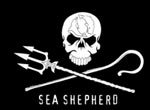 After having their toy racing boat, Ady Gil sunk in a collision with a whaling ship; after experiencing engine problems as well as having the registration of their converted whaler, the B0b Barker, pulled by the Togolese; after having the captain of the Ady Gil arrested when he boarded a Japanese whaler; and then after using the Steve Irwin to pelt the Japanese ships with crocodile bath toys, the Sea Shepherds have ended their season of harassment and are sailing for home. They have proclaimed it their “most successful” season yet. And so another year of this dangerous farce comes to a close.
After having their toy racing boat, Ady Gil sunk in a collision with a whaling ship; after experiencing engine problems as well as having the registration of their converted whaler, the B0b Barker, pulled by the Togolese; after having the captain of the Ady Gil arrested when he boarded a Japanese whaler; and then after using the Steve Irwin to pelt the Japanese ships with crocodile bath toys, the Sea Shepherds have ended their season of harassment and are sailing for home. They have proclaimed it their “most successful” season yet. And so another year of this dangerous farce comes to a close.
Anti-whaling activists end Antarctic campaign
For the record, we also oppose Japanese whaling, but we do not support the vigilante violence of the Paul Watson and his bumbling seagoing circus. Thanks to Captain D. Peter Boucher of the Nautical Log for the heads up
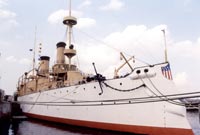
USS Olympia
Terrible news from Phildelphia.
Philadelphia maritime museum says it can’t afford to care for historic USS Olympia
A Philadelphia maritime museum says it can no longer afford to care for a historic ship that served in the Spanish-American War.
Continue reading
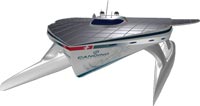 The windjammers liked the higher latitudes where the winds are stronger. This solar craft will try to still as close to the equator as possible to maximize the sunshine. The catamaran reminds me of something out of Star Trek, perhaps a Romulan transport ship.
The windjammers liked the higher latitudes where the winds are stronger. This solar craft will try to still as close to the equator as possible to maximize the sunshine. The catamaran reminds me of something out of Star Trek, perhaps a Romulan transport ship.
 After rosy announcements about the restoration of the Cutty Sark an article in the Telegraph has a very different view of the ongoing project.
After rosy announcements about the restoration of the Cutty Sark an article in the Telegraph has a very different view of the ongoing project.
Cutty Sark restoration turning into a fiasco
The restoration of the Cutty Sark is turning into a fiasco which could seriously damage or even destroy one of Britain’s most famous ships, it can be revealed.
Continue reading

Heinz Stahlschmidt
Heinz Stahlschmidt, a renegade former member of Germany’s World War Two navy, who thwarted plans to wreck the French port of Bordeaux by retreating Nazi forces, has died at the age of 91, officials said. Thanks to Andy Hall at the Maritime Texas Blog for pointing it out.
Renegade German war hero who saved French port dies
Heinz Stahlschmidt was serving as a petty officer in the Kriegsmarine when he was ordered to help prepare the destruction of the southwestern city’s port facilities as the Germans pulled out ahead of advancing allied troops.
Instead, he set off an explosion in the bunker holding detonators and time fuses for the planned demolition, preventing mass carnage in the port area and, according to some historians, possibly saving up to 3,500 lives.
Continue reading
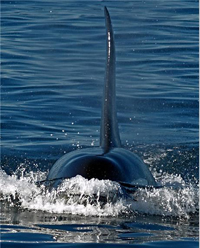 SeaWorld tragedy — a reminder of why orcas should swim free?
SeaWorld tragedy — a reminder of why orcas should swim free?
For wildlife conservationists, the tragic death of SeaWorld trainer Dawn Brancheau is a sobering reminder of why creatures as large and majestic as killer whales simply should not live in captivity.
The World Society for the Protection of Animals and the Whale and Dolphin Conservation Society are just two of the organizations that have campaigned against the practice. First, they say, killer whales in captivity often get sick and live on average only into their 20s (though there are exceptions). In the wild, the females typically live into their 50s or beyond and the males at least into their 30s.
Continue reading

Tilikum
Orcas, commonly known as killer whales, have never been known to kill a human in the wild. The same is not true of orcas in captivity. Today Tilikum, a 12,300 pound bull orca, the largest whale in captivity, attacked and drowned a female trainer at Sea World’s Shamu Stadium in Orlando, FL. This is not the first trainer death associated with Tilikum. He was also involved with two other orcas in 1992 in the death of a trainer at Sealand of the Pacific near Victoria, British Columbia. Tilikum was at the scene of a death of park visitor on July 6, 1999. Tilikum is not the only captive killer whale to have attacked a trainer. In December of last year, a trainer was also drowned after being held underwater by a killer whale in a Spanish zoo. Since the 1970s more than ten cases of trainers attacked by orcas have been recorded.
Killer Whale Kills SeaWorld Trainer In Front Of Shocked Audience
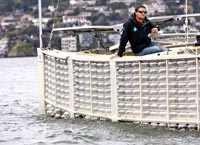 Last March we posted Plastiki – Boat made of plastic bottles to make ocean voyage about a project in which David de Rothschild intended to build and sail a catamaran made of around 12,000 recycled soda bottles across the Pacific. Almost a year later Plastiki is getting ready to sail.
Last March we posted Plastiki – Boat made of plastic bottles to make ocean voyage about a project in which David de Rothschild intended to build and sail a catamaran made of around 12,000 recycled soda bottles across the Pacific. Almost a year later Plastiki is getting ready to sail.
Trash floats eco-warrior’s boat
David de Rothschild is talking trash, lots and lots of trash.
“There were 25 billion Styrofoam cups used last year. How do you even get your head around what 25 billion Styrofoam cups looks like?” he said. “Eighty-odd percent of what’s purchased by Americans is thrown out within six months.”
Continue reading
 USS Constitution Model Shipwright Guild’s Annual Model Ship Show – Models in the Spotlight – Running through March 20th. Admission to the Museum and the exhibit are free; donations are welcome. A total of 75 different ships created by modelers from across New England will be on display.
USS Constitution Model Shipwright Guild’s Annual Model Ship Show – Models in the Spotlight – Running through March 20th. Admission to the Museum and the exhibit are free; donations are welcome. A total of 75 different ships created by modelers from across New England will be on display.
Haunted night at Hull Maritime Museum – Hull’s Maritime Museum will hold its first ever haunted night. The ghoulish event will take place in the dark hours of Saturday, May 15. It comes after several staff members experienced spooky happenings in the 140-year-old building.
Continue reading
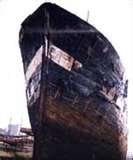 BC apparently has posted an interesting videocast on the composite clipper City of Adelaide. I write apparently because it is available only in Britain and being on the other side of the pond I can only take the word of my British friends. The BBC does have an interesting blog post nevertheless. Thanks to David Hayes for passing the link along.
BC apparently has posted an interesting videocast on the composite clipper City of Adelaide. I write apparently because it is available only in Britain and being on the other side of the pond I can only take the word of my British friends. The BBC does have an interesting blog post nevertheless. Thanks to David Hayes for passing the link along.
Is bringing a tall ship back to the Wear too much of a tall order?
In more of less related news a battle of the ballads has broken out between UK singer/songwriters and an Australian singer songwriter. All are attempting to pen and sing music to save the ship though the Brits want her to be returned to the River Ware where she was built, while the Australian would like her returned to her namesake city.
 The historic riverboat, Becky Thatcher, a 220-foot, 74-year-old stern-wheeler sank in the Ohio River off Neville Island near Pittburgh, apparently due to the weight of a record snowfall which also collapsed the top two decks.
The historic riverboat, Becky Thatcher, a 220-foot, 74-year-old stern-wheeler sank in the Ohio River off Neville Island near Pittburgh, apparently due to the weight of a record snowfall which also collapsed the top two decks.
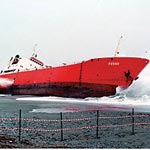 A very disturbing article in this months Scientific American suggesting that criminal groups have been scuttling ships containing chemical and pharmaceutical waste, effectively using the Mediterranean as a toxic dump site. Thanks to Steve Phelps for pointing it out.
A very disturbing article in this months Scientific American suggesting that criminal groups have been scuttling ships containing chemical and pharmaceutical waste, effectively using the Mediterranean as a toxic dump site. Thanks to Steve Phelps for pointing it out.
Poisoned Shipments: Are Strange, Illicit Sinkings Making the Mediterranean Toxic?
Continue reading
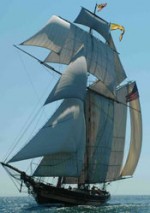
Pride of Baltimore II
There are twelve tall ships scheduled to participate in Green Bay, Wisconsin’s Tall Ship festival this August, though at this point, only six names have been announced. These are the HMS Bounty, the schooners Roseway, Amistad, the Pride of Baltimore II, the Unicorn and the S/V Denis Sullivan.

Cross-sectional drawing of a Microburst
Captain William Curry of the SV Concordia is reporting that the school ship was struck by a microburst, also referred to a white squall, which knocked down the 188′ three masted schooner, rolling the ship 90 degrees. She sank in twenty minutes. Microbursts are capable of generating wind speeds higher than 75 m/s (168 mph; 270 km/h). All aboard made it to the lifeboats and were rescued.
We’ve made it! British teenagers survive 40-hour ordeal after ship is sunk by towering waves
The captain also reported that the ship capsized on Wednesday rather than Thursday as had been previously reported.
The schooner Pride of Baltimore in 1986 and the school ship Albatross in 1961 are both believed to have been capsized by microbursts or “white squalls.” Microbursts also cause “wind shear” which has been blamed for the crashes of several commercial air liners.
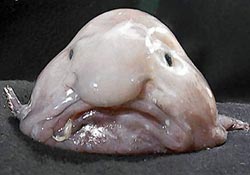
The Blobfish
An intriguing if slightly disturbing article and photo from the LA Times:
As scary as the jumping Asian carp may be, there’s something even scarier – the blobfish.
As you can see from the accompanying photograph, the cunning blobfish (Psychrolutes marcidus) is the most terrifying fish in the world. And if you’re not afraid of it yet, you should be, because there’s always something lurking out there that can get you.
Continue reading
